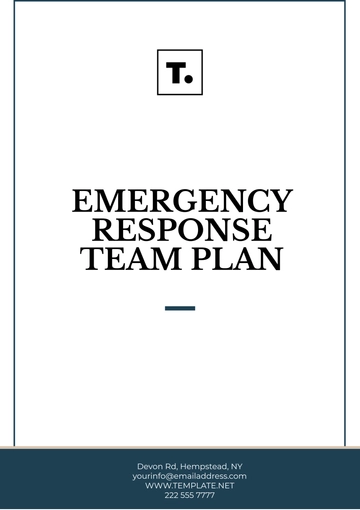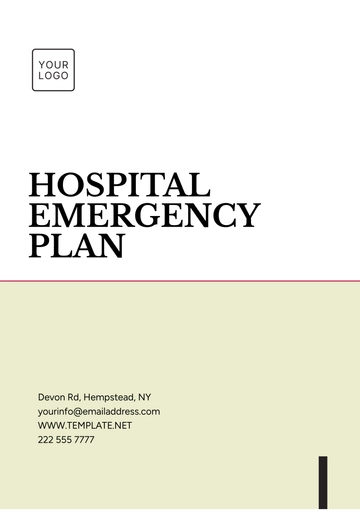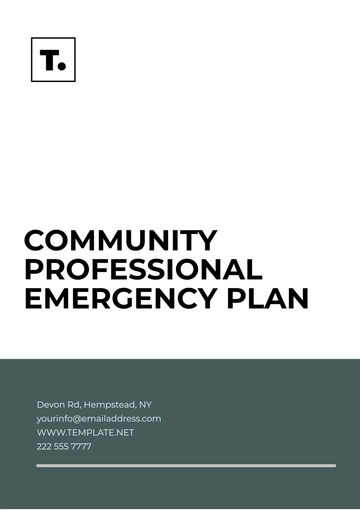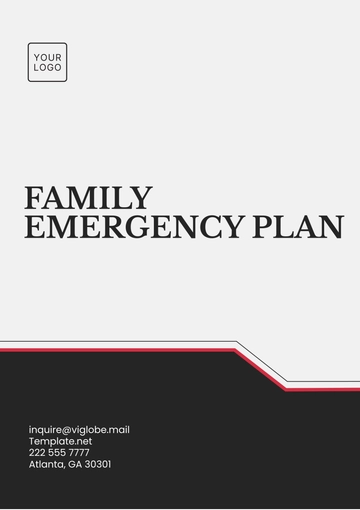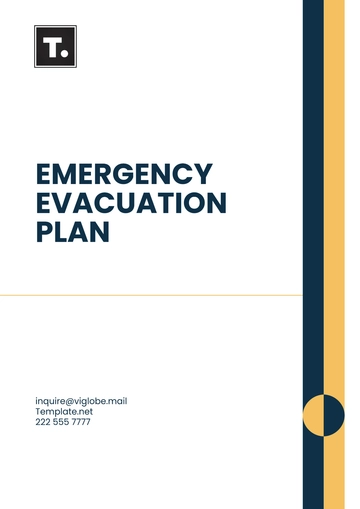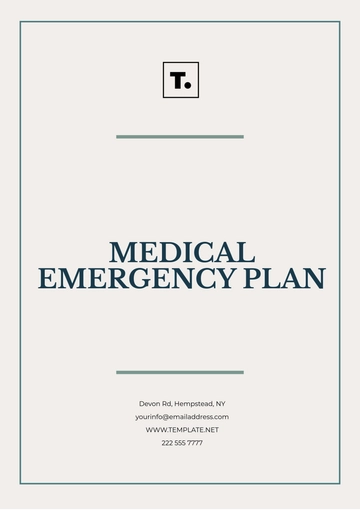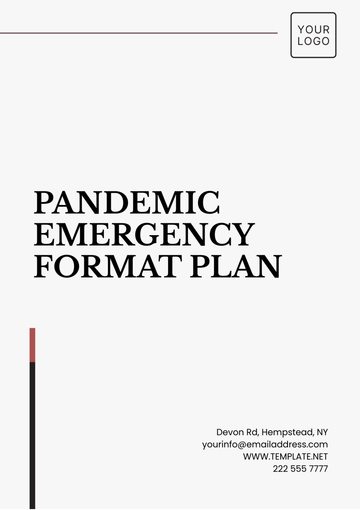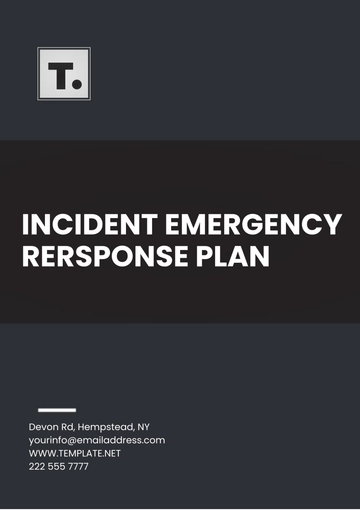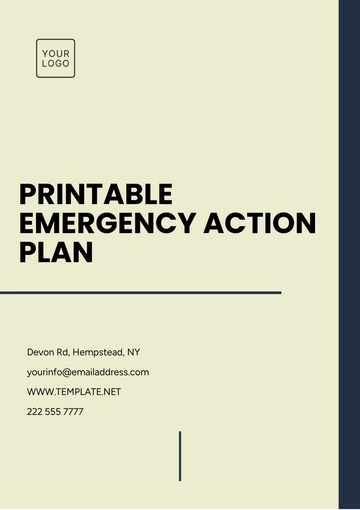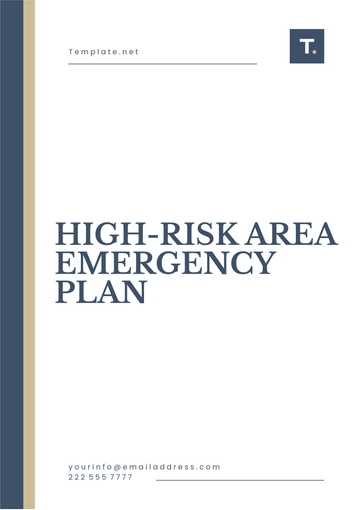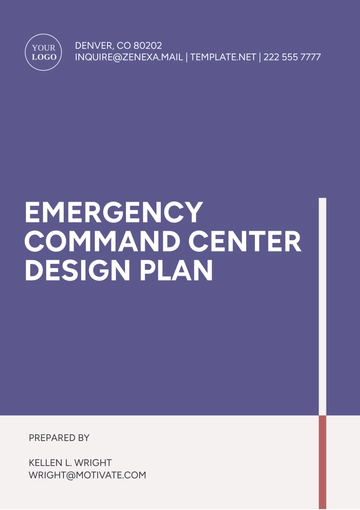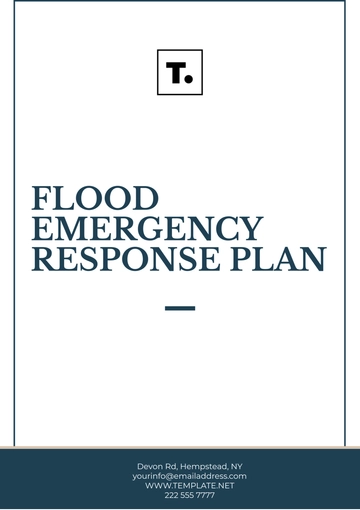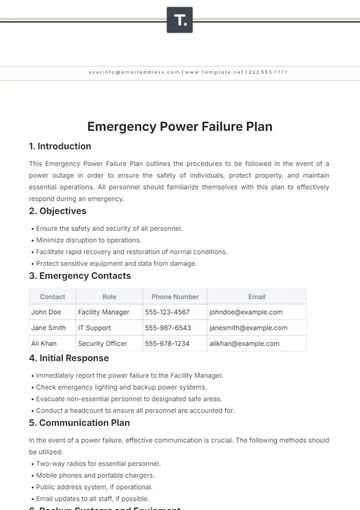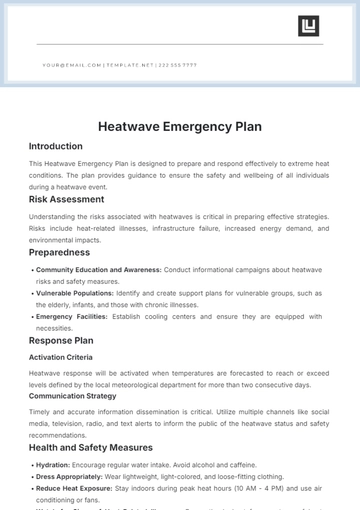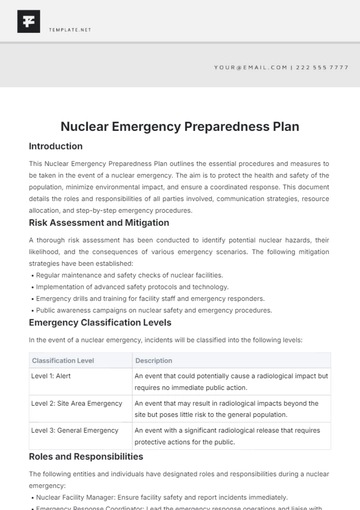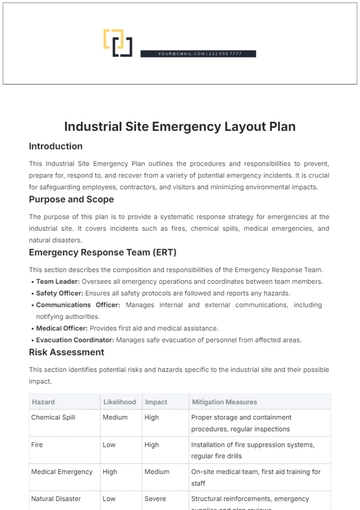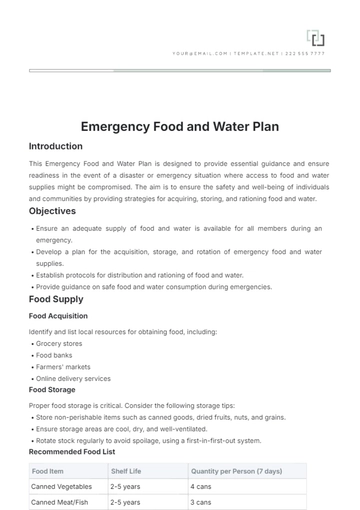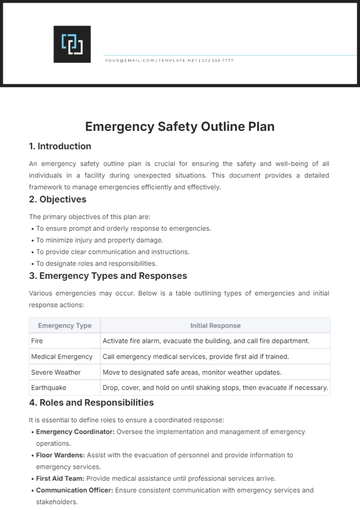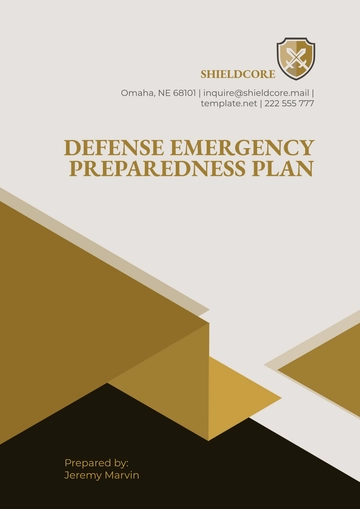Free Defense Emergency Preparedness Plan
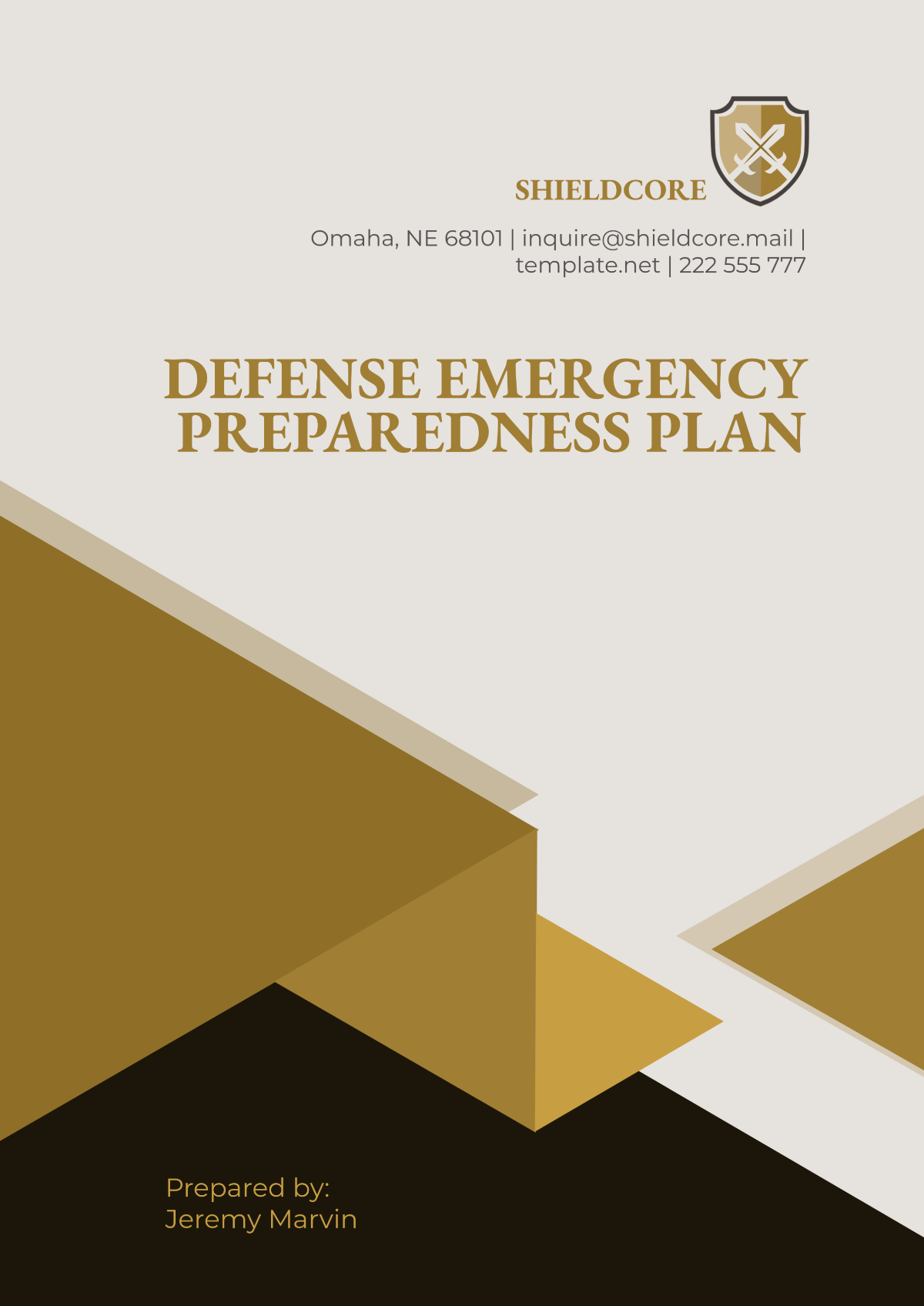
I. INTRODUCTION
A. Purpose of the Plan
The purpose of this Defense Emergency Preparedness Plan is to ensure that [Your Company Name] can effectively respond to any emergency scenario that may threaten national security, business operations, and public safety. This plan aims to outline the procedures, resources, and personnel required to safeguard critical operations, protect personnel, and mitigate the impact of potential crises. It is designed to be flexible and scalable, addressing a wide variety of emergencies, including military conflicts, natural disasters, cyber-attacks, and technological disruptions.
B. Scope and Objectives
This plan applies to all operations within [Your Company Name], with an emphasis on defense-critical functions. The objectives include ensuring operational continuity, minimizing damage to assets, and maintaining a coordinated response between military, civilian, and government entities. It is structured to provide a clear chain of command and operational guidance for both planned and unplanned emergencies.
C. Key Definitions and Terminology
Critical Infrastructure: Assets or facilities crucial for national security and essential operations.
Continuity of Operations (COOP): The ability to maintain essential functions during and after an emergency.
Command and Control: Systems and procedures used to direct emergency response actions and communication.
D. Authorities and Legal Framework
The DEPP is aligned with federal and state emergency response protocols, including the National Defense Authorization Act (NDAA) and Homeland Security Presidential Directives (HSPD). This plan also complies with international law, including the Geneva Conventions, to ensure adherence to humanitarian standards during military or security responses. Additionally, it ensures compliance with cybersecurity regulations under the Cybersecurity Information Sharing Act (CISA).
E. Review and Revision Process
The DEPP will be reviewed and updated annually, with a complete revision occurring every two years. Feedback from real-world incidents, national security assessments, and new intelligence will guide these revisions. The plan will undergo simulations and drills to identify areas of improvement and ensure readiness.
II. THREAT ASSESSMENT AND RISK ANALYSIS
A. Identification of Potential Threats
Military Aggression: The likelihood of conventional military conflicts involving advanced weaponry such as cyber-attacks on defense infrastructure and AI-driven warfare systems.
Natural Disasters: Increasing frequency of severe weather events, including hurricanes, earthquakes, and wildfires, exacerbated by climate change.
Technological Threats: The potential for widespread disruption caused by cyber-attacks targeting critical infrastructure, including power grids, communication systems, and data networks.
B. Risk Analysis Methodology
The Risk Assessment framework involves a probabilistic model that evaluates the likelihood and severity of each threat. An impact scale from 1 to 5 is used, with 5 representing catastrophic consequences and 1 representing low-impact scenarios. Threats are analyzed based on past incidents, intelligence reports, and predictive models.
C. Prioritization of Threats
Threat Type | Likelihood (1-5) | Impact (1-5) | Priority Level |
|---|---|---|---|
Military Aggression | 4 | 5 | High |
Natural Disasters | |||
Technological Threats |
III. OPERATIONAL RESPONSE STRATEGY
A. Command and Control Structure
The emergency response will be coordinated through the Central Command Center (CCC), located in [Location], which will serve as the hub for real-time coordination. The Incident Commander will be appointed from the highest level of leadership and will oversee all response actions, working with representatives from local, state, and federal agencies. A chain of command will be established, with designated roles for each department to ensure swift decision-making.
B. Emergency Protocols
In the event of an emergency, the Emergency Response Team (ERT) will be activated immediately, with personnel mobilized based on the severity and nature of the threat. All essential personnel will receive immediate briefing and instructions on actions to take, including evacuation, containment, or deployment. Communication between team members will be maintained through secure channels, ensuring operational confidentiality and security.
C. Deployment Strategies
Rapid Deployment Forces: Specially trained units will be deployed to affected areas within 2 hours, with immediate focus on securing critical infrastructure.
Reserve Forces and Reinforcements: Additional units and reserves will be mobilized within 24 hours to support primary teams.
Strategic Mobility: Deployment will include air, land, and sea-based transport to ensure rapid response, with priority given to areas under direct threat.
IV. RESOURCE MANAGEMENT
A. Identification of Critical Resources
Key resources include AI-powered defense systems, autonomous drones for reconnaissance and combat support, and advanced medical technology for rapid recovery efforts. Logistics systems will ensure that food, water, fuel, and other necessary supplies are delivered efficiently during an emergency. All critical infrastructure will be monitored using Internet of Things (IoT) devices for real-time tracking.
B. Resource Allocation Protocols
In the event of an emergency, resources will be allocated based on priority needs, ensuring that military operations and critical infrastructure repair are supported first. Key personnel will be assigned roles in resource distribution, and all movements will be tracked using blockchain technology to ensure transparency and prevent misallocation. Periodic drills will be held to simulate resource shortages and identify response gaps.
C. Infrastructure Protection and Restoration
Critical Infrastructure | Protection Strategy | Restoration Timeline |
|---|---|---|
Military Command Centers | Secure underground facilities | 6-12 hours |
Communications Networks | Hardened communication lines | 12-24 hours |
Power Grid and Utilities | Backup power via generators | 24-48 hours |
V. TRAINING AND EXERCISES
A. Regular Drills and Simulations
Annual full-scale drills will simulate various crisis scenarios, including natural disasters, cyber-attacks, and military invasions. These exercises will involve coordination with local authorities, federal agencies, and private sector partners. After each exercise, feedback sessions will be conducted to evaluate effectiveness and identify areas for improvement.
B. Personnel Training Programs
Personnel will undergo advanced training in crisis management, leadership under pressure, and emergency medical response. Virtual simulations and AI-driven scenarios will be used to enhance decision-making skills. Specialized teams will receive training in handling chemical, biological, radiological, and nuclear (CBRN) threats.
C. Evaluation and Improvement
All drills will be followed by an After Action Review (AAR) to assess performance, identify strengths, and address weaknesses. Key performance indicators (KPIs) will be used to track improvements and ensure alignment with updated national security strategies. Continuous improvement will be a key aspect of the plan, with updates integrated based on new technologies, emerging threats, and lessons learned.
VI. COMMUNICATIONS PLAN
A. Secure Communications Channels
Communication will be facilitated through secure military-grade encrypted systems, with all channels monitored for unauthorized access. Backup communication systems will be in place to ensure functionality in the event of a cyber-attack or disruption. Personnel will have access to satellite phones and secure digital messaging platforms for real-time updates.
B. Interagency Coordination
Coordination will be conducted through a centralized operations room, where information from local, state, and federal entities will be shared. Liaison officers will be deployed to establish direct communication between various agencies, ensuring smooth coordination. Regular teleconference drills will ensure swift interagency communication during emergencies.
C. Public Information and Media Strategy
Press releases and public statements will be issued through official channels to ensure that the public receives accurate, timely information. A designated spokesperson will be available 24/7 to address media inquiries, and a public information hotline will be established for civilians. Social media platforms will be monitored to prevent misinformation.
VII. CONTINGENCY AND RECOVERY PLANS
A. Continuity of Operations (COOP)
In the event of a significant disruption, the Continuity of Operations (COOP) plan will ensure that mission-critical functions can continue with minimal downtime. Key personnel will be relocated to pre-designated Alternate Command Centers (ACC) to continue operations. Redundant systems, such as backup communication tools and secondary power grids, will be in place to maintain essential services and operations.
B. Recovery Operations
The recovery phase will begin immediately after the crisis has subsided, with an initial damage assessment team deployed within 12 hours. The primary focus will be on restoring military capabilities and critical infrastructure, with secondary efforts directed at civilian support and rebuilding damaged communities. A Recovery Task Force will oversee the prioritization and deployment of resources for infrastructure restoration, medical support, and economic stabilization.
C. Post-Emergency Debrief and Analysis
After an emergency, an After Action Review (AAR) will be conducted to evaluate the overall response, identify what went well, and determine areas for improvement. A Lessons Learned report will be compiled and shared with relevant agencies to improve future preparedness efforts. The DEPP will be revised based on these findings, and updates will be integrated into training, resource management, and operational procedures.
VIII. LEGAL AND ETHICAL CONSIDERATIONS
A. Rules of Engagement and Use of Force
The Rules of Engagement (ROE) will be strictly adhered to during all emergency operations to ensure compliance with international humanitarian law. The use of force will be proportionate and aimed at ensuring the protection of personnel and critical infrastructure. All military actions will be authorized at the appropriate level of command and will follow legal frameworks governing the use of force in national defense.
B. Data Protection and Privacy Concerns
In accordance with General Data Protection Regulation (GDPR) and other privacy laws, all sensitive data collected during emergency responses will be stored securely and shared only with authorized personnel. Encryption and multi-factor authentication will be used to safeguard personnel data, operational communications, and critical infrastructure details. During a cyber-attack, all actions will be taken to prevent breaches and minimize damage to privacy and proprietary information.
C. Humanitarian Laws and Crisis Response
Humanitarian laws and principles will be followed during all phases of response, ensuring that civilians, including refugees and displaced persons, are treated with dignity and provided necessary support. Relief efforts will focus on the immediate needs of affected populations, including medical care, shelter, and food. Humanitarian aid will be coordinated through the United Nations (UN) and other international agencies to ensure an organized and comprehensive response.
IX. PLAN MAINTENANCE AND CONTINUOUS IMPROVEMENT
A. Review and Update Cycle
The Defense Emergency Preparedness Plan will be reviewed annually, with an in-depth revision conducted every two years. Updates will be based on new intelligence, technological advancements, emerging threats, and lessons learned from exercises and real-world emergencies. A committee of senior defense planners, emergency response experts, and legal advisors will oversee the review and update process to ensure the plan remains current and effective.
B. Adaptation to Changing Security Environments
The DEPP will be adapted to respond to the evolving global security environment, including shifts in geopolitical dynamics, technological advancements in warfare, and climate change-induced crises. Regular assessments will be conducted to identify potential new threats, such as biotechnological warfare or AI-driven conflict, and appropriate modifications will be made to the plan. Integration of emerging technologies, such as autonomous defense systems and quantum computing for cybersecurity, will be prioritized.
C. Integration of Lessons Learned
After every emergency, exercise, and threat simulation, a formal debrief will occur to gather feedback from all involved parties. The findings will be used to refine the DEPP and improve overall readiness. A dedicated feedback loop will ensure that any weaknesses identified during real-world crises or exercises are addressed in the next revision cycle, fostering continuous improvement.
Conclusion
The Defense Emergency Preparedness Plan is a dynamic and robust framework designed to safeguard national security and ensure the continuity of critical operations during emergencies. By integrating advanced technologies, clear command structures, and comprehensive resource management strategies, [Your Company Name] will be fully equipped to respond to a wide range of potential crises. Regular reviews, training exercises, and interagency coordination will guarantee that the plan remains effective and adaptable to future challenges.
- 100% Customizable, free editor
- Access 1 Million+ Templates, photo’s & graphics
- Download or share as a template
- Click and replace photos, graphics, text, backgrounds
- Resize, crop, AI write & more
- Access advanced editor
Provide a comprehensive and customizable solution with the Defense Emergency Preparedness Plan Template from Template.net. This editable plan offers flexibility to tailor strategies to your specific needs, ensuring robust preparedness for any crisis. With the integrated AI Editor Tool, you can easily modify the content and structure, ensuring a personalized and effective emergency response plan.
You may also like
- Finance Plan
- Construction Plan
- Sales Plan
- Development Plan
- Career Plan
- Budget Plan
- HR Plan
- Education Plan
- Transition Plan
- Work Plan
- Training Plan
- Communication Plan
- Operation Plan
- Health And Safety Plan
- Strategy Plan
- Professional Development Plan
- Advertising Plan
- Risk Management Plan
- Restaurant Plan
- School Plan
- Nursing Home Patient Care Plan
- Nursing Care Plan
- Plan Event
- Startup Plan
- Social Media Plan
- Staffing Plan
- Annual Plan
- Content Plan
- Payment Plan
- Implementation Plan
- Hotel Plan
- Workout Plan
- Accounting Plan
- Campaign Plan
- Essay Plan
- 30 60 90 Day Plan
- Research Plan
- Recruitment Plan
- 90 Day Plan
- Quarterly Plan
- Emergency Plan
- 5 Year Plan
- Gym Plan
- Personal Plan
- IT and Software Plan
- Treatment Plan
- Real Estate Plan
- Law Firm Plan
- Healthcare Plan
- Improvement Plan
- Media Plan
- 5 Year Business Plan
- Learning Plan
- Marketing Campaign Plan
- Travel Agency Plan
- Cleaning Services Plan
- Interior Design Plan
- Performance Plan
- PR Plan
- Birth Plan
- Life Plan
- SEO Plan
- Disaster Recovery Plan
- Continuity Plan
- Launch Plan
- Legal Plan
- Behavior Plan
- Performance Improvement Plan
- Salon Plan
- Security Plan
- Security Management Plan
- Employee Development Plan
- Quality Plan
- Service Improvement Plan
- Growth Plan
- Incident Response Plan
- Basketball Plan
- Emergency Action Plan
- Product Launch Plan
- Spa Plan
- Employee Training Plan
- Data Analysis Plan
- Employee Action Plan
- Territory Plan
- Audit Plan
- Classroom Plan
- Activity Plan
- Parenting Plan
- Care Plan
- Project Execution Plan
- Exercise Plan
- Internship Plan
- Software Development Plan
- Continuous Improvement Plan
- Leave Plan
- 90 Day Sales Plan
- Advertising Agency Plan
- Employee Transition Plan
- Smart Action Plan
- Workplace Safety Plan
- Behavior Change Plan
- Contingency Plan
- Continuity of Operations Plan
- Health Plan
- Quality Control Plan
- Self Plan
- Sports Development Plan
- Change Management Plan
- Ecommerce Plan
- Personal Financial Plan
- Process Improvement Plan
- 30-60-90 Day Sales Plan
- Crisis Management Plan
- Engagement Plan
- Execution Plan
- Pandemic Plan
- Quality Assurance Plan
- Service Continuity Plan
- Agile Project Plan
- Fundraising Plan
- Job Transition Plan
- Asset Maintenance Plan
- Maintenance Plan
- Software Test Plan
- Staff Training and Development Plan
- 3 Year Plan
- Brand Activation Plan
- Release Plan
- Resource Plan
- Risk Mitigation Plan
- Teacher Plan
- 30 60 90 Day Plan for New Manager
- Food Safety Plan
- Food Truck Plan
- Hiring Plan
- Quality Management Plan
- Wellness Plan
- Behavior Intervention Plan
- Bonus Plan
- Investment Plan
- Maternity Leave Plan
- Pandemic Response Plan
- Succession Planning
- Coaching Plan
- Configuration Management Plan
- Remote Work Plan
- Self Care Plan
- Teaching Plan
- 100-Day Plan
- HACCP Plan
- Student Plan
- Sustainability Plan
- 30 60 90 Day Plan for Interview
- Access Plan
- Site Specific Safety Plan

